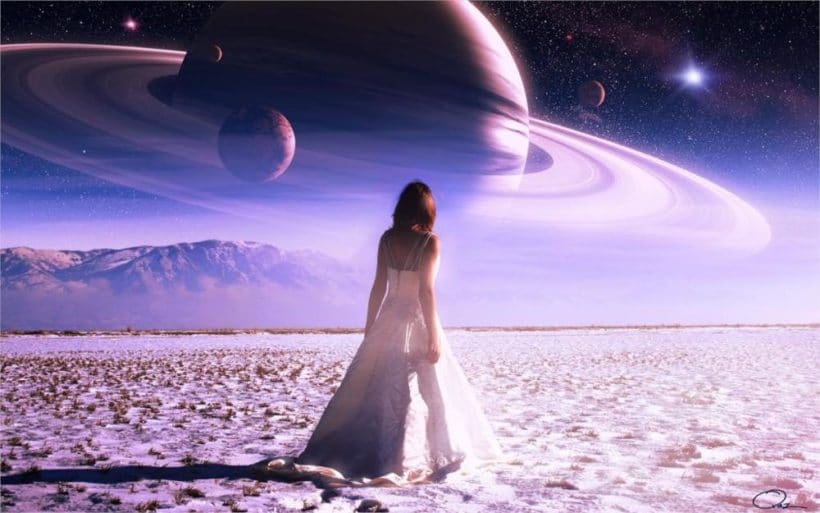
by Somya Devi | Sep 18, 2017 | Astrology, Conjunctions, Holy Days, Planets Changing Signs
New Moon in Virgo
The new lunar cycle begins Tuesday, September 19th, at 10:30 pm PDT, with Sun and Moon in sidereal Virgo. After a couple of months full of a lot of emotion and fire with many planets (and eclipses!) in Cancer and Leo, we have a chance to ground out a little bit more under the influence of earth-sign Virgo. Virgo is ruled by Mercury, the planet of the intellect, which brings a more practical and impartial nature to our energies this month. There is opportunity for curiosity and learning. The cycle begins in the Vedic nakshatra called Uttara Phalguni, which reminds us to take time in relaxation in order to re-kindle our productive energy.
The placement of Mercury and the nodes at the time of the Dark Moon, however, continue to make for a strong amount of “shadow” and subconscious energy to be present. Mercury, the lord of Virgo, will be in the 12th house from the Sun and Moon, and joining closely with Mars, showing a lot of intensity in the subconscious and potential for feeling disconnected. This New Moon also occurs under a full kala sarpa yoga, an alignment in which all seven planets are in between the two nodes of the Moon, Rahu and Ketu, in the cosmic circle.

Kala Sarpa
The kala sarpa yoga can be translated as “black snake” or “serpent of time.” The Moon transits the entire zodiac each month, so for two weeks of each month Moon will be on the other side of this axis, breaking the kala sarpa yoga, but for half of the month all planets will fall on one side of the “black serpent.” This will occur frequently over the next several months, when all seven planets will be situated to one side of the nodal axis (see photo) for half the month. The Moon transits the entire zodiac each month, so for two weeks of each month Moon will be on the other side of this axis, breaking the kala sarpa yoga, but for half of the month all planets will fall on one side of the “black serpent.”
When this alignment occurs, more of the shadowy and subconscious energy represented by the nodes is present. We may expect to be more introverted during this time, but it is also possible that more disruptive events can occur. People who are born under this alignment tend to have many “heavy” experiences throughout life. There can still be many positive and auspicious events during this time as well (or for those born under a kala sarpa yoga), but they tend to come after or despite some hardships or challenges.
Look for this yoga to occur for half the month from now through January of 2018. We experienced a similar occurrence last year (2016) from roughly September through January. This doesn’t happen every year, but we happen to be in a time where both Jupiter and Saturn, the slower-moving planets, are both to one side of the nodal axis. Thus this alignment occurs when the faster-moving planets, Sun, Mars, Mercury, and Venus, (plus Moon for half of each month) are also on one side of the axis.
Navaratri
Thankfully, there is a wonderful opportunity at hand to get in touch with the shadowy, subconscious energy of the nodes, through ritual worship and practice offered by Navaratri, the “nine-night” festival of the Goddess, which begins on the first day of this lunar cycle. This is a Hindu festival dedicated to worshiping the Goddess, Devi, in her many forms, for nine days and nights. As the night represents darkness and ignorance, we pray to her to help reveal and remove our shortcomings, bestow blessings, and confer wealth and knowledge. We face the darkness and call on the Divine Mother to remove it and let the atman, or the pure divinity within each of us, shine forth.
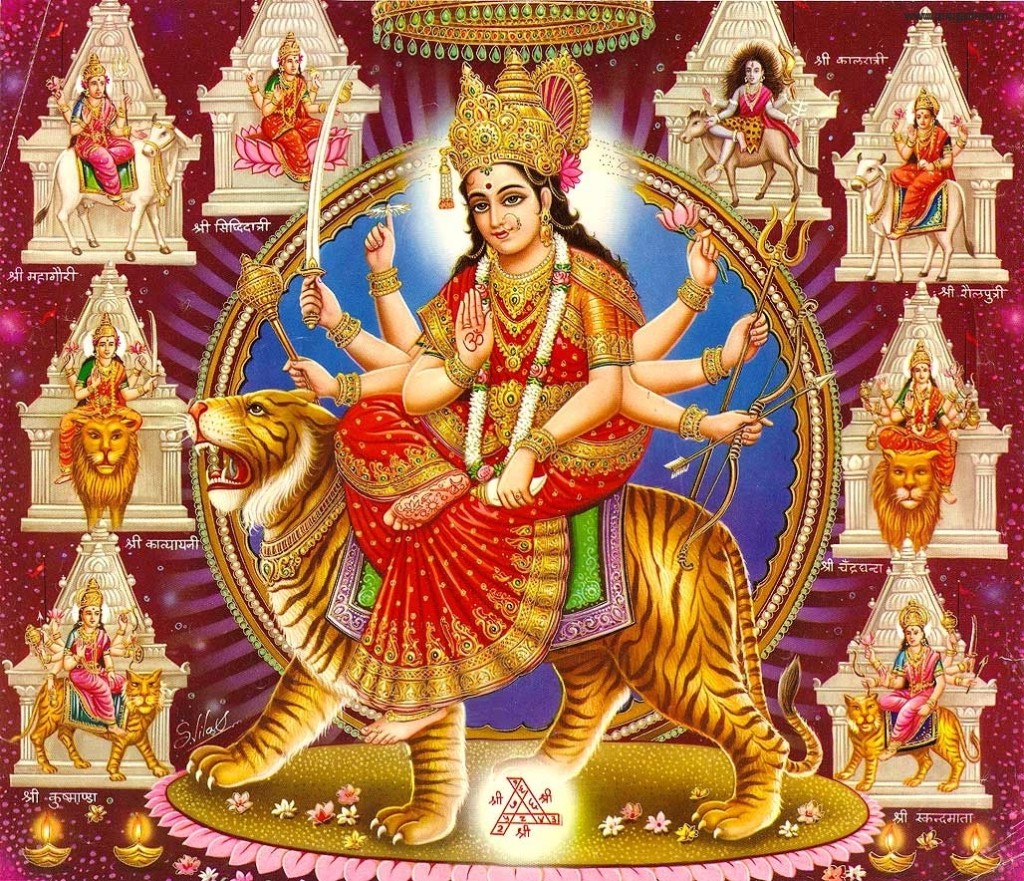 Navaratri worship can include creating a special altar to the Goddess, and making daily offerings including flowers, food, incense, light (a flame), ghee, as well as prayer, meditation, mantras and bhajans (devotional songs). The Devi Mahatmya (a.k.a. Chandi Path), the story of Durga, is a traditional text to read throughout this festival. Occurring in the fall-time in India and the northern hemisphere, this Navaratri also coincides with the harvest season, and is a time to give thanks for the abundance of the harvest and pray that it carries us through the winter season.
Navaratri worship can include creating a special altar to the Goddess, and making daily offerings including flowers, food, incense, light (a flame), ghee, as well as prayer, meditation, mantras and bhajans (devotional songs). The Devi Mahatmya (a.k.a. Chandi Path), the story of Durga, is a traditional text to read throughout this festival. Occurring in the fall-time in India and the northern hemisphere, this Navaratri also coincides with the harvest season, and is a time to give thanks for the abundance of the harvest and pray that it carries us through the winter season.
In many places, the first three nights of Navaratri are dedicated to Goddess in the form of Durga or Kali, warrior goddesses who help us to cleanse our impurities, the next three to Lakshmi, goddess of prosperity and devotion, and the last three to Sarasvati, goddess of wisdom. In other traditions, there are nine different forms of the Goddess honored on each of the nine days and nights. Be sure to follow me to receive daily updates throughout the festival!
Nodes Have Changed Signs
Since the onset of the eclipse cycle in early September, the nodes, Rahu and Ketu, have fully transitioned from the Leo-Aquarius axis to the Cancer-Capricorn axis. This completes one year-and-a-half transit as it begins another. From now through March of 2019, we will experience Rahu in Cancer and Ketu in Capricorn. The obsessive, insatiable Rahu in Cancer will cause us to experience a heightened state of emotionality throughout this time, with perhaps overwhelming sensitivity at times. The confusion of the nodes impels us to take time to get a better understanding of our hearts, and much will be revealed around the eclipse cycles that come in January-February 2018, July-August 2018, and January-February 2019.
With Ketu now transiting sidereal Capricorn, we will have to observe our shadows in the way that we balance our emotional nature with our practicality. Ketu in Capricorn could make us resistant to taking responsibility and practical steps for the future, but he will eventually raise self-awareness around any challenges we have here. We can be very self-critical in the area of Ketu’s transit, which will also affect each individual where Capricorn falls in the natal chart. Conversely, we may encounter impatience, restlessness, and even lust in the area of life indicated by Cancer in our natal chart, while Rahu transits there. I am happy to offer this Full Report and Forecast for Your Sign Here. (If you’re already on the free mailing list, you’ll be getting it in your inbox later today!)
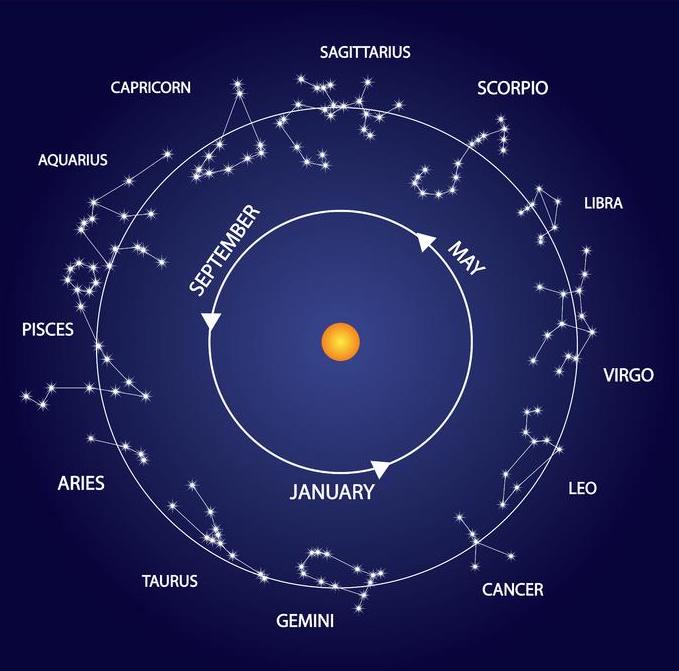
Jupiter in Virgo/Libra
Jupiter has technically transitioned zodiac signs recently, moving from sidereal Virgo’s into sidereal Libra’s designated slice of the pie-in-the-sky. Virgo is a much larger constellation than Libra, however, and in areas where abundant stars are visible just after sunset, one can see that Jupiter is still traversing the constellation of Virgo. The two do not each take up 30° of the 360° ring of the zodiac, in real observational terms, but rather Virgo takes up more than that portion while Libra covers less. Thus, we may be beginning to feel some energy of Jupiter in Libra (more inspiration for harmony, compromise, and the arts), I believe we are still experiencing a strong quality of Jupiter in Virgo (elevating our desire for organization of life’s details).
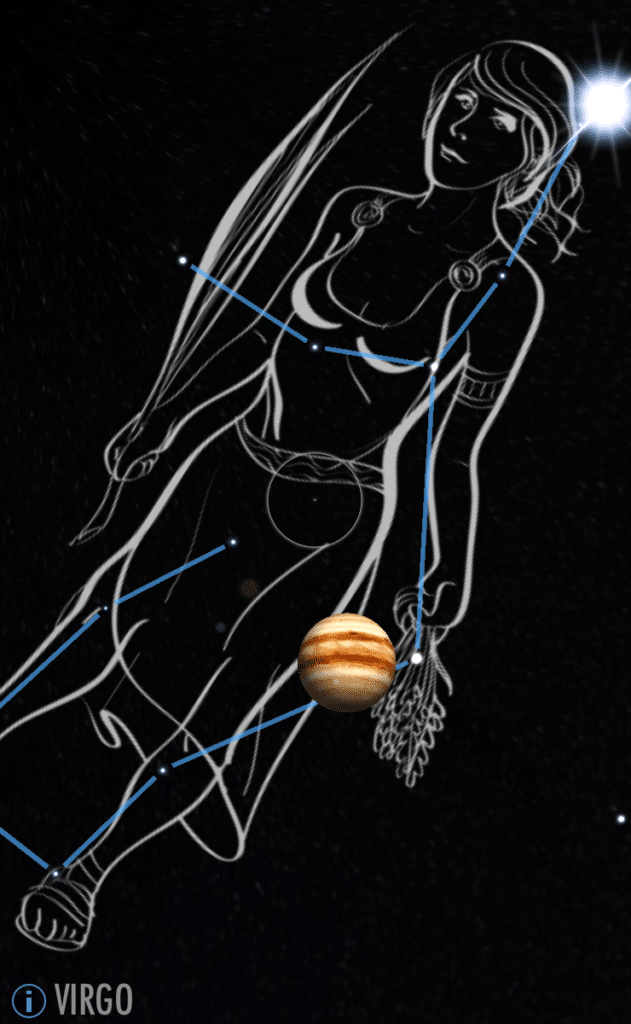 Also remember, most Western astrologers will say that Jupiter has been in Libra for the last year already, which can cause some confusion. That is based on the tropical zodiac, based on the seasons. Now is a great example of how the tropical zodiac does not correlate with the observable position of the planets and constellations as we see them from earth.
Also remember, most Western astrologers will say that Jupiter has been in Libra for the last year already, which can cause some confusion. That is based on the tropical zodiac, based on the seasons. Now is a great example of how the tropical zodiac does not correlate with the observable position of the planets and constellations as we see them from earth.
In the Vedic zodiac, Jupiter is still considered to be in the constellation of Chitra, which bridges the designations of Virgo and Libra. This nakshatra correlates with the star called Spica within Virgo (which Jupiter is closely conjunct at the moment), and translates as “the brilliant,” as it is one of the brightest stars in the sky. It is the sign of the celestial architect, and does bring forth a strong artistic quality. This is, therefore, a good time to allow your artistic inspiration to shine through, especially through both skillful and intelligent endeavors.
Mercury, Mars and Venus in Leo
Mercury, Mars, and Venus are all transiting sidereal Leo now. Venus in Leo can cause us to bring forth a lot of “me-first” in relationships, while the proximity of Mars and Mercury in this fire sign can lead to arguing, so be especially aware of these tendencies this month. The three are all catching an aspect from Saturn, now moving forward in direct motion in Scorpio, so that could help to add some mature caution to our impulses.
Save
Save
Save
Save
Save
Save
Save
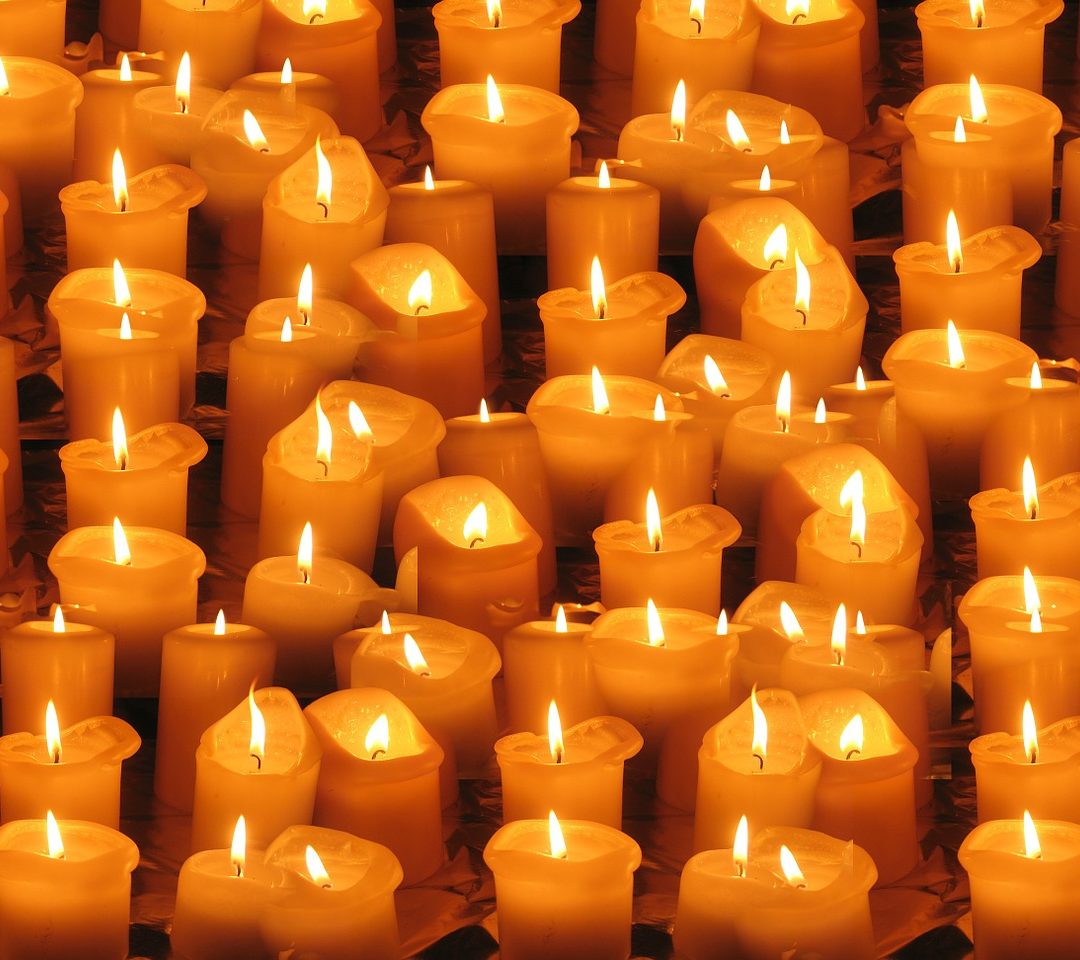
by Somya Devi | Oct 26, 2016 | Astrology, Conjunctions, Events, Holy Days
New Moon in Swati
Be careful not to become scattered this New Moon in Swati, on the dark night of Saturday, October 29th (*Times given for North America).
The Sun and Moon will coincide in this Vedic star-sign ruled by Vayu, the Lord of Wind, to kick off the next lunar cycle. The exact conjunction will be Sunday morning (at 10:38 a.m. PDT), with the darkest Moon phase on Saturday night. It will also coincide with a Venus-Saturn planetary war (exact conjunction), so we may feel a conflict between temporary pleasures and long-term goals (October 28-30). Thankfully, this dark Moon night also marks the time for celebrating Diwali (or Deepawali), the festival of light, wherein we celebrate prosperity and light prevailing over darkness! So it’s a great time to shine some light and turn our minds and hearts toward devotional practice.
Potential Depletion
There are a few factors creating the potential to feel scattered at this time, but there’s also a great opportunity to ground ourselves and steady our minds through focus and worship. In addition to Vayu’s influence, we in the Northern Hemisphere have been experiencing the cold winds increasing in the external atmosphere. As we go deeper into autumn, the vata dosha (comprised of air and ether elements) is increasing all around us. With the leaves falling and the weather changing, the process of decrease and sparsity in nature becomes evident. This results in an increase of vata energy, which can cause us to feel restless, anxious, spacey, dry, or depleted. It is extra important to do grounding and nourishing practices during this season, and to eat warm, moist, and heavier foods.***
What’s more, this lunar cycle begins with the Sun and Moon in Libra, where Sun is considered debilitated (not able to express strongly). Sun represents our vitality, energy, physical strength, and also our feeling of spiritual strength and connection with universal source. Not surprisingly, the time of year when he becomes “debilitated,” passing through Libra, is the same time we experience increased vata in the atmosphere and lessened immunity in our systems. It’s the time when we are most likely to catch a cold and begin to feel “spread thin” or “dried out.” While the Sun is in Libra, self-care is extra important. Take some time on this New Moon night to set intentions for how you will care for yourself during the coming cycle.
Another reason Sun is considered debilitated in Libra is because Libra is a sign that is very much about relationships. Sun represents our individual strength, so with Sun in Libra, we are more likely to put more of our attention on others, and on relationships, than towards our own physical health. We may be relating to our own personal power through our relationships during this time, rather than approaching it as individuals. While you are offering your love and compassion to others, don’t forget to nourish the divine within yourself as well, or you may end up feeling depleted. It is also easy to become drained when we try too hard to balance everything, another temptation of Sun in Libra.
Swati Symbolism
Thankfully, the divine universe always seems to offer just the right opportunities for solving the same challenges it presents. We just need to be willing to do the work on ourselves. This new Moon is in the part of Libra known as Swati, “the independent one,” which reminds us of our independent nature, despite the strong emphasis we may be putting on relationships at the moment. This star-sign helps remind us to look for our own inherent power, shining forth like the inner Sun.
Vayu, the wind god, is the ruler of Swati, and can bring in a restless and scattered energy to this star. He is also the father of Lord Hanuman, who is known as the greatest devotee. One lesson we learn from Hanuman is that through loving devotion, even a restless monkey mind can be tamed. He had endless devotion for Lord Rama, which gave him invincible powers to accomplish seemingly impossible tasks. Though we all have restless monkey minds at times, if we direct our attention toward love, light, or our chosen deity, we will be able to steady the mind and find immense strength within.
Practice Ideas
Some ways to still your mind through one-pointed focus include:
- Mantra recitation
- Asana practice
- Scriptural study
- Meditation on candlelight, a statue, or an image
Though a young sprout blowing in the wind (a symbol of Swati) may seem perilous, it is actually growing stronger so as to withstand the intense force of the outer circumstances. Eventually, it could grow into a tall redwood, cutting through the wind like a sword (another symbol of Swati). Swati is also related to the symbolism of a priest, which shows us the possibility for reclaiming both power and balance through devotional or spiritual practice.
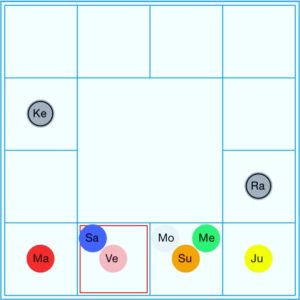 Kala Saarpa Yoga
Kala Saarpa Yoga
We may feel extra intensity seemingly out of nowhere, for the next two weeks during which the planets align in a Kala Saarpa yoga. This means that the seven major planets are all in between Rahu and Ketu, the two lunar nodes. This heavy alignment can bring up a lot of shadow work, so it is a good time to engage your toolbox for self-development. With Ketu in Shatabisha, the sign of the “hundred medicines,” alternative medicines and healing modalities can be useful towards this end.
Diwali
With all this energy in the atmosphere, enjoy the opportunity for worship offered by the advent of Diwali! This Hindu festival of light is celebrated for 6 or 7 days, with the main Diwali festival on the night of October 29th. Diwali, or Deepawali, comes from Deepa + avali, “a row of lights.”
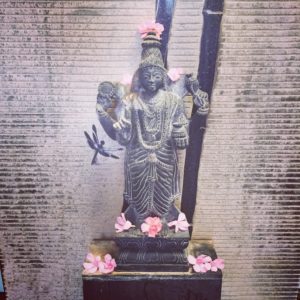 Thursday (North America) is both Dhanvantari Tryodashi (or Dhanvantari Jayanti, the birth of Lord Dhanvantari), and Dhanteras (a part of the Diwali festival). It is the thirteenth day of the waning Moon in the Vedic month of Ashwayuja. Lord Dhanvantari is known as the “father of Ayurveda” and the “physician of the Gods.” (Ayurveda is the system of natural medicine from India that is a sister science to yoga and Jyotish.) If you practice any healing tradition, especially Ayurveda, this is a good day to give thanks and call in auspicious blessings to your healing path or practice.
Thursday (North America) is both Dhanvantari Tryodashi (or Dhanvantari Jayanti, the birth of Lord Dhanvantari), and Dhanteras (a part of the Diwali festival). It is the thirteenth day of the waning Moon in the Vedic month of Ashwayuja. Lord Dhanvantari is known as the “father of Ayurveda” and the “physician of the Gods.” (Ayurveda is the system of natural medicine from India that is a sister science to yoga and Jyotish.) If you practice any healing tradition, especially Ayurveda, this is a good day to give thanks and call in auspicious blessings to your healing path or practice.
Thursday also marks Dhanteras, the first day of the Diwali festival (the Hindu festival of light). It commemorates the day that Lakshmi emerged from the milk ocean. In India, it is customary to purchase metals on this day — anything from jewelry to new statues to kitchenware (excluding iron), as a part of celebrating Lakshmi and calling in more prosperity. The metals can then be offered to your altar and will absorb and amplify the benefits of worship performed over the few days of Diwali.
It is customary to perform a puja to Lakshmi on the third night of Diwali (this Saturday in North America). Goddess Lakshmi represents wealth and prosperity (spiritual and material), as well as devotion, love, beauty, and happiness. Celebrating her on Diwali is a way to call these qualities into our lives.
It is also traditional to light candles throughout Diwali, to remind us of the divine light within. Diwali is also related to the story from the Ramayana about Lord Rama’s return from exile after fourteen years. It thus symbolizes light and goodness emerging from times of darkness. Lord Rama represents dharma, or doing our duty, as well as devotion, compassion, courage, and righteous leadership. Diwali celebrations often commemorate his and Sita’s return to the kingdom of Ayodhya after their exile.
On Saturday night as we prepare to enter the next lunar cycle, light a candle! Turn your mind toward the divine so as to focus and ground, through the practices that work best for you. Set some intentions as to how you will practice self-care during this cycle (and be sure to find me on Facebook for a live chat with tips for how to do this!).
Ram Ram, Namaste
***Be sure to Follow me on Facebook so you can tune in for my upcoming Facebook Live talks about the New Moon AND Ayurvedic tips for how to stay balanced during the high vata season!
**Limited requests for personal Vedic Astrology readings before the New Year are now available Here.
Save
Save
Save
Save
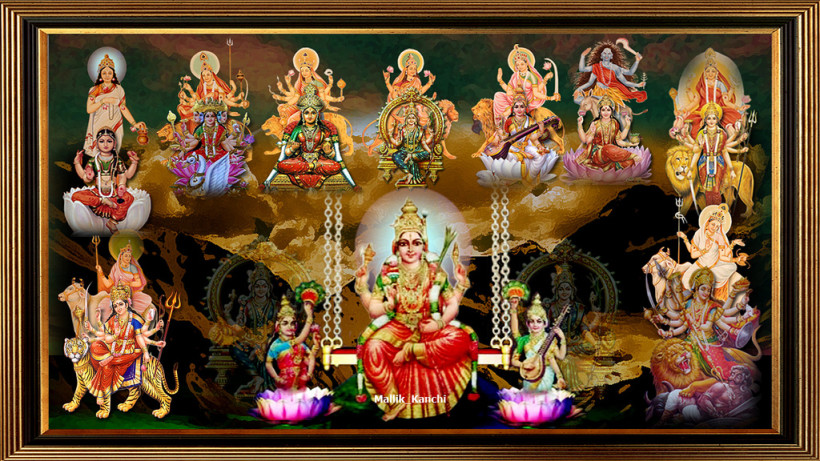
by Somya Devi | Oct 12, 2015 | Astrology, Holy Days
For the first nine days and nights of the waxing Moon this lunar cycle we celebrate Navaratri (starting October 13th in North America). Literally the “nine nights,” this is a Hindu festival dedicated to worshipping the Goddess, Devi, in her many forms, for nine days and nights. There are nine forms of Durga that are typically celebrated each day. We celebrate the power of Shakti, the sacred dynamic feminine principle of divine energy. We pray to her to help reveal and remove our shortcomings, bestow blessings, and confer wealth and knowledge. Navaratri worship can include many forms of puja (ritual prayer). These can include creating a special altar to the Goddess, and making daily offerings including flowers, food, incense, light (a flame), ghee, as well as prayer, meditation, mantras and bhajans (devotional songs). The Devi Mahatmyam (a.k.a. Chandi Path), the story of Durga, is a traditional text to read throughout this festival. Occurring in the fall-time in India and the northern hemisphere, this Navaratri also coincides with the harvest season, and is a time to give thanks for the abundance of the harvest and pray that it carries us through the winter season.
Goddess is worshipped over the nine nights in the form of nine incarnations of Durga (Navadurga). These are Shailputri, Brahmacharini, Chandraghanta, Kushmanda, Skandamata, Katyayani, Kalaratri, Mahagauri and Siddhidatri. Below are the stories of these goddesses, how to worship them, what they represent, as well as what colors and planets are associated with the nine days of Navaratri.
In many places, worship is dedicated to Goddess as Durga, Lakshmi and Sarasvati, for three nights each. Durga helps us to destroy and remove negative tendencies in our minds and hearts, cleansing them of impurities that create obstructions in our spiritual and material pursuits. Lakshmi helps us to cultivate positive qualities, like compassion and devotion. She helps us to achieve spiritual and material prosperity. Sarasvati assists us with learning and attaining knowledge and wisdom, through the illumination of consciousness. She relates to prana, the vital breath, often associated with chi or life-force. Through our devotion, service, practice, study, and meditation, we allow prana to flow freely and enter a state of peace, bliss, and oneness. The tenth day of Navaratri is known as Vijayadashami, the day of victory, and is a time for auspicious beginnings after emerging from these nine days of worship and union with the Goddess.
May your connection to the Divine Mother and Shakti within deepen and blossom during this time. Jai Ma!
First Day of Navaratri: Goddess as Shailputri
Tuesday, October 13th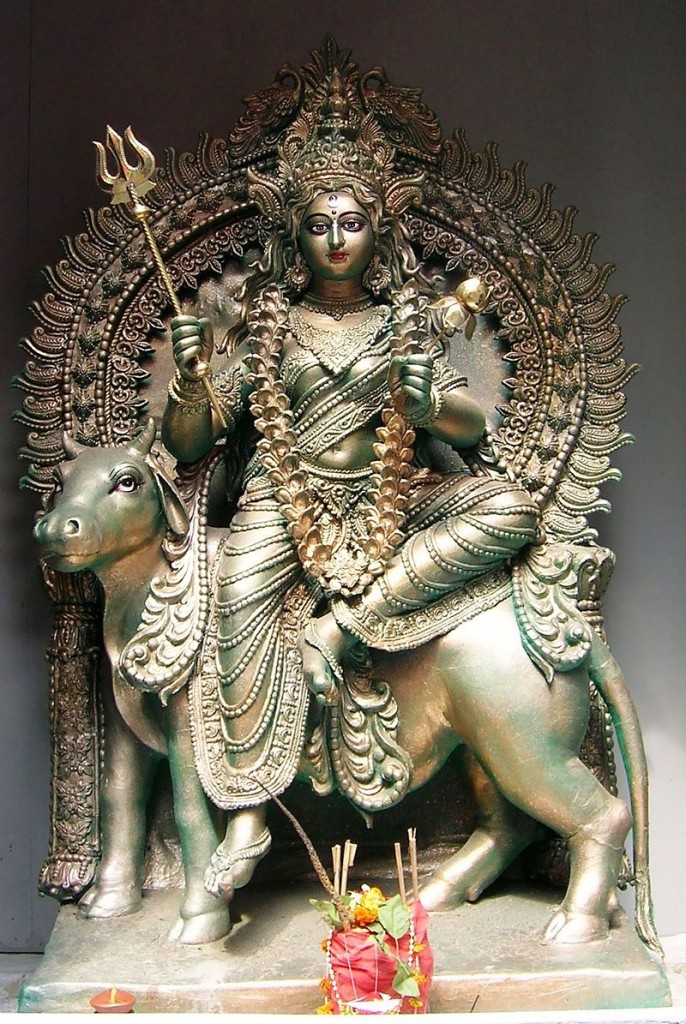
On the first day of Navaratri, On the first day of Navaratri, we honor Goddess in the form of Shailputri (a form of Durga), the “daughter of the mountains.” In the story of Shiva and Shakti, Shiva’s wife first incarnated as Sati, but Sati ended up sacrificing herself in a ceremonial fire because of her father’s (Daksha’s) disapproval of her husband. It was foretold that she would be born again to a father who respected the divine ascetic, and thus she reincarnated as Parvati, also called Hemavati (the daughter of Himavat, personification of the Himalayan mountains), or Shailputri (literally “daughter of the mountain”).
Shailputri rides a bull, Nandi, and carries a trident and a lotus in her hands. She rules the Moon (Chandra) and wears a crescent Moon on her forehead, just like her consort, Shiva. She is the mother of Kartikeya and Ganesha, and thus represents creative energy. She relates to the muladhara (root chakra), where we begin the journey of awakening the divine energy within, in the process of letting it rise into union with divine consciousness. It is good to concentrate on the root chakra today. Shailputri is a fitting goddess to worship for initiations and auspicious beginnings, and for the first day of Navaratri, as we are beginning the process of awakening Shakti. Devi’s color is red, which can be worn on all the nights of Navaratri, especially tonight.
Second Day of Navaratri: Goddess as Brahmacharini
Wednesday, October 14th
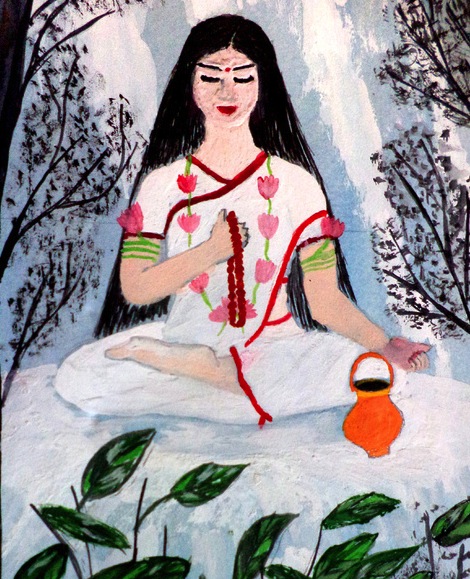 On the second day of Navaratri we worship Goddess as Brahmacharini, she who practices penance. Another form of Parvati and Durga, Brahmacharini is the form of the goddess who endured tapas or austerities (penance) to win the heart of Lord Shiva (representative of sublime consciousness). As he was an ascetic dedicated to austere meditations in solitude, the high-born Parvati forsook her father’s wealthy abode and chose the sadhu life of self-discipline and renunciation in order to attain spiritual growth. She went to live in the forest, enduring the elements, forgoing food and water, and meditating for eons. Brahmacharini is depicted in bare feet, holding a japa mala (prayer beads), and a kamandal (a simple water-pot, often carried by sadhus), and wearing rudrakshas (the bead related to Shiva and renunciation).
On the second day of Navaratri we worship Goddess as Brahmacharini, she who practices penance. Another form of Parvati and Durga, Brahmacharini is the form of the goddess who endured tapas or austerities (penance) to win the heart of Lord Shiva (representative of sublime consciousness). As he was an ascetic dedicated to austere meditations in solitude, the high-born Parvati forsook her father’s wealthy abode and chose the sadhu life of self-discipline and renunciation in order to attain spiritual growth. She went to live in the forest, enduring the elements, forgoing food and water, and meditating for eons. Brahmacharini is depicted in bare feet, holding a japa mala (prayer beads), and a kamandal (a simple water-pot, often carried by sadhus), and wearing rudrakshas (the bead related to Shiva and renunciation).
Although fasting is a suitable practice for all nine days of Navaratri (some fasts include milk or milk and fruit), it is especially potent to offer oneself to Goddess by fasting today. By worshipping Brahmacharini through simple offerings, prayer, and our own self-discipline, she blesses us with emotional and spiritual strength, and the ability to persevere through hardships. She represents and offers us loyalty, devotion, and spiritual growth and wisdom. She rules the planet Mars (Mangala), the planet of strength and courage, who assists us in overcoming weakness and practicing yogic discipline. The term brahmacharini also refers to female renunciates in the Hindu faith, who choose a life of tapas (austerity) and dedication to the Lord, rather than worldly life.
Third Day of Navaratri: Goddess as Chandraghanta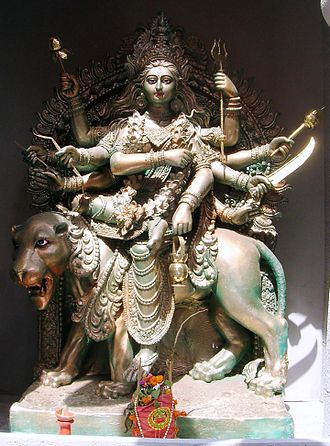
Thursday, October 15th
On the third day of Navaratri we celebrate Goddess as Chandraghanta, a powerful form of Durga. She wears a half-Moon (Chandra) in the shape of a bell (ghanta) oh her forehead. Riding a lion or a tiger, she has 10 arms in which she holds many weapons, as well as a japa mala, a lotus, a kamandal, and mudras (hand-positions) offering blessings and protection. Posed as a warrioress, she is ready to destroy the obstacles and enemies of her devotees. She rules the planet Venus (Shukra), and is truly a gentle goddess. Chandraghanta is full of love and compassion, and wants to bestow happiness and prosperity on those who worship her. This form of the Divine Mother brings us courage as well as grace and beauty. Worshipping her helps to remove suffering and to grant us serenity.
Fourth Day of Navaratri: Goddess as Kushmanda
Friday, October 16th
 On the fourth day of Navaratri we celebrate Goddess as Kushmanda, the power of Shakti that created the universe. It is said that when there was only darkness, Kushmanda smiled and the universe was illuminated. She is known as Adi Shakti, the first Shakti, creatrix of everything. She resides in the center of the Sun (Surya), and creates his bright light from her “cosmic egg.” She is radiant and glowing, and spreads warmth as well as vitality to her devotees. Kushmanda rides a lion or tiger and has 8 arms, holding many weapons, as well as a lotus, a japa mala, and a pot of honey or divine nectar.
On the fourth day of Navaratri we celebrate Goddess as Kushmanda, the power of Shakti that created the universe. It is said that when there was only darkness, Kushmanda smiled and the universe was illuminated. She is known as Adi Shakti, the first Shakti, creatrix of everything. She resides in the center of the Sun (Surya), and creates his bright light from her “cosmic egg.” She is radiant and glowing, and spreads warmth as well as vitality to her devotees. Kushmanda rides a lion or tiger and has 8 arms, holding many weapons, as well as a lotus, a japa mala, and a pot of honey or divine nectar.
Worshipping Kushmanda helps us to feel the spark of divine existence that radiates from the Sun to and through us all. She helps us to attain strength, good health, happiness and spiritual illumination. She is said to bestow siddhis (special powers) and thus can assist us in achieving success in many areas of life, including wealth, material comfort, and relationships. The power of the Sun enhances our positive and sattvic qualities through our worship of Kushmanda. She relates to the ahahata (heart chakra), and as such we should remember to approach her and make offerings from the purity of our hearts.
In some areas where Navaratri is dedicated to Durga, Lakshmi, and Sarasvati for three nights each, today begins the worship of MahaLakshmi. After calling upon the energy of Durga for three days to destroy our demons (shortcomings, false beliefs, and external obstacles), we now invoke Lakshmi, the Goddess of prosperity. She helps us to attain both material and spiritual wealth, including virtues such as devotion and compassion. Through worshipping Lakshmi and seeking her benevolence, we call forth the benevolence from within ourselves which will bring joy and happiness as we share it with others. Similarly, the warmth and energy of Kushmanda and the Sun is meant to be shared with others from the heart, which will help us to find ourselves in a kingdom of love and light.
Fifth Day of Navaratri: Goddess as Skandamata
Saturday, October 17th
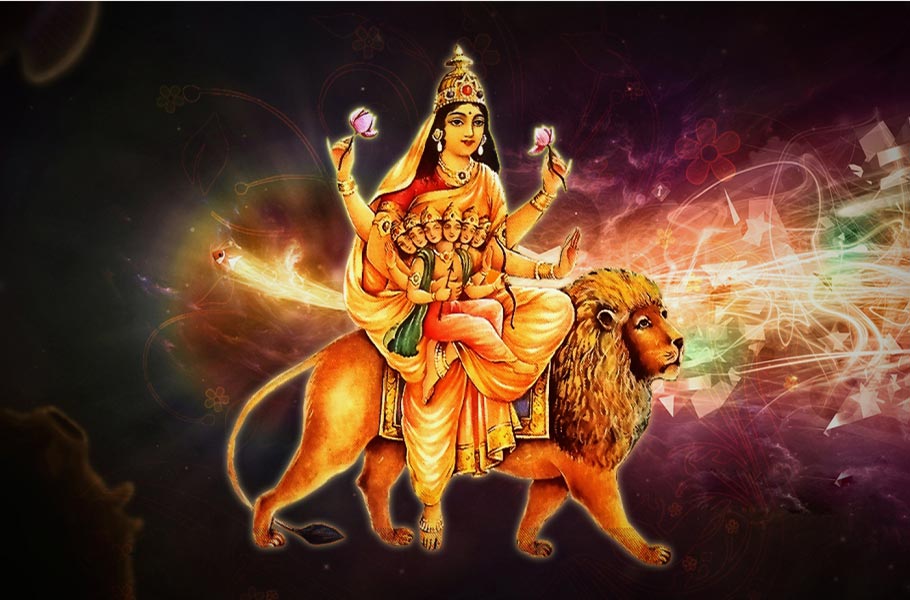 On the fifth day of Navaratri we celebrate Goddess in the form of Skandamata (literally the “mother of Skanda”). Skanda is a name for Kartikeya (also known as Murugun and Subramanya), the brother of Ganesha (both sons of Shiva and Parvati). We see Skandamata depicted holding her young six-headed son, as well as holding lotus flowers and keeping one hand in a blessing mudra. In worshiping her we call forth the protection and care that the Divine Mother has for all of creation, as all are her children. She blesses us with bliss, happiness, and motherly love, as well as nourishment and good health.
On the fifth day of Navaratri we celebrate Goddess in the form of Skandamata (literally the “mother of Skanda”). Skanda is a name for Kartikeya (also known as Murugun and Subramanya), the brother of Ganesha (both sons of Shiva and Parvati). We see Skandamata depicted holding her young six-headed son, as well as holding lotus flowers and keeping one hand in a blessing mudra. In worshiping her we call forth the protection and care that the Divine Mother has for all of creation, as all are her children. She blesses us with bliss, happiness, and motherly love, as well as nourishment and good health.
Kartikeya is the Lord of War, the leader of the army of devas (Gods) who fight the asuras (demons) in Hindu mythology. In the stories, the demon Tarakasura was tormenting all of humanity, and it was destined that only Lord Shiva’s son would be able to kill him and save the world. Shiva had renounced everything and was lost in meditation, however, after the death of his first wife, Sati. The Gods devised a plan and ensured that Parvati was born (a reincarnation of Sati), and followed a path that would result in Shiva’s emerging from meditation and remarrying. When they finally married, Shiva and Parvati ended up making love for millions of years while the world awaited their savior. Eventually, the fire deity, Agni, snuck into their cave in order to steal the seed that was needed. It was so hot that he could not hold it, however, and dropped it in the river Ganga (another manifestation of Goddess), who deposited the infant Skanda on her banks where he was found and nourished by six women (thus the six heads).
The demons represent the ignorance which gives rise to all human impurities and misfortune. In worshiping Skandamata we also worship Skanda and receive his blessings, including protection from harm and victory over our enemies, both internal and external. Skandamata relates to the vishuddhi (throat chakra), meaning “pure” or “undiluted,” showing that we can attain purity and realize infinite blessings through her worship. She is rules the planet Mercury (Budha), the planet and deity of communication and the intellect.
Sixth Day of Navaratri: Goddess as Katyayani
Sunday, October 18th
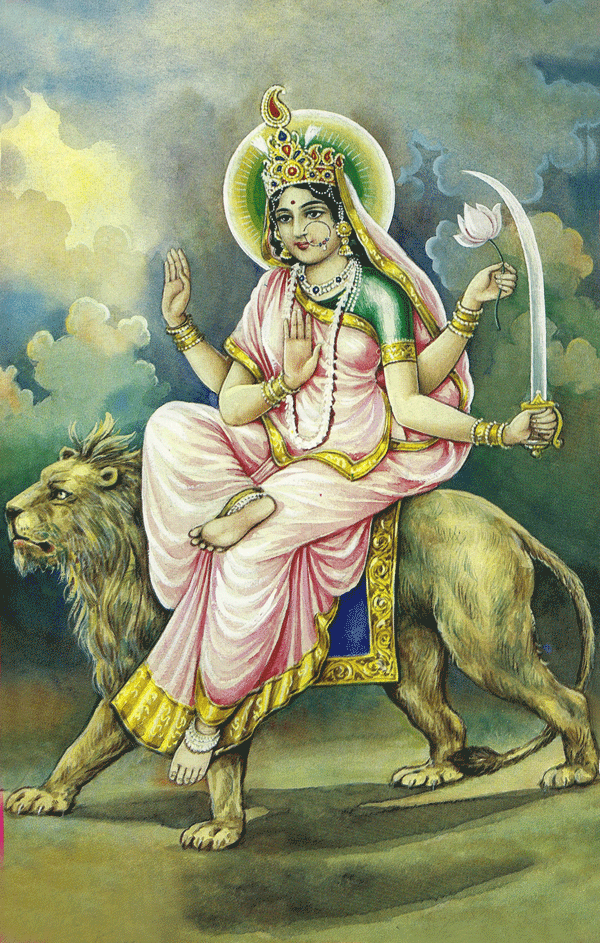 On the sixth day of Navaratri we celebrate Goddess in the form of Katyayani, the warrioress who destroyed Mahishasura (the buffalo demon). Mahishasura had been granted a boon (unbreakable wish) from Lord Brahma that determined that no man could kill him. Thus, when he was terrorizing the earth and heavens, the Gods summoned Goddess Durga to come and save them. This form of Durga is named Katyayani, for her father Katya, a devoted sage who did rigorous penance in order to have Durga take birth as his daughter. Katyayani takes a fierce form of the Divine Mother when we call upon her to destroy our demons, including both internal negativities and external obstacles to material and spiritual success. She relates to the ajna (the third-eye) chakra, where we draw our concentration during worship today.
On the sixth day of Navaratri we celebrate Goddess in the form of Katyayani, the warrioress who destroyed Mahishasura (the buffalo demon). Mahishasura had been granted a boon (unbreakable wish) from Lord Brahma that determined that no man could kill him. Thus, when he was terrorizing the earth and heavens, the Gods summoned Goddess Durga to come and save them. This form of Durga is named Katyayani, for her father Katya, a devoted sage who did rigorous penance in order to have Durga take birth as his daughter. Katyayani takes a fierce form of the Divine Mother when we call upon her to destroy our demons, including both internal negativities and external obstacles to material and spiritual success. She relates to the ajna (the third-eye) chakra, where we draw our concentration during worship today.
Katyayani relates to fervent devotion, and it is told that she was also worshipped by the Gopis of Vrindavan, who called on her to help them win Lord Krishna as their husband. It is said that worshiping Katyayani will help in bringing a good relationship and marriage, as she bestows the strength to remove obstacles. She also rules Jupiter (Guru), who represents husband in a woman’s astrological chart. Jupiter brings grace, expansion, and optimism, just as Katyayani helps us to fight sorrow and fear. Katyayani is related to fragrances, and offering her incense and other aromatics is a good practice to include in worship today. Through healing scents she helps us to fight disease and improve health. She holds both a lotus and a sword in two of her hands, and holds the other two in mudras offering protection and blessings.
Seventh Day of Navaratri: Goddess as Kalaratri
Monday, October 19th
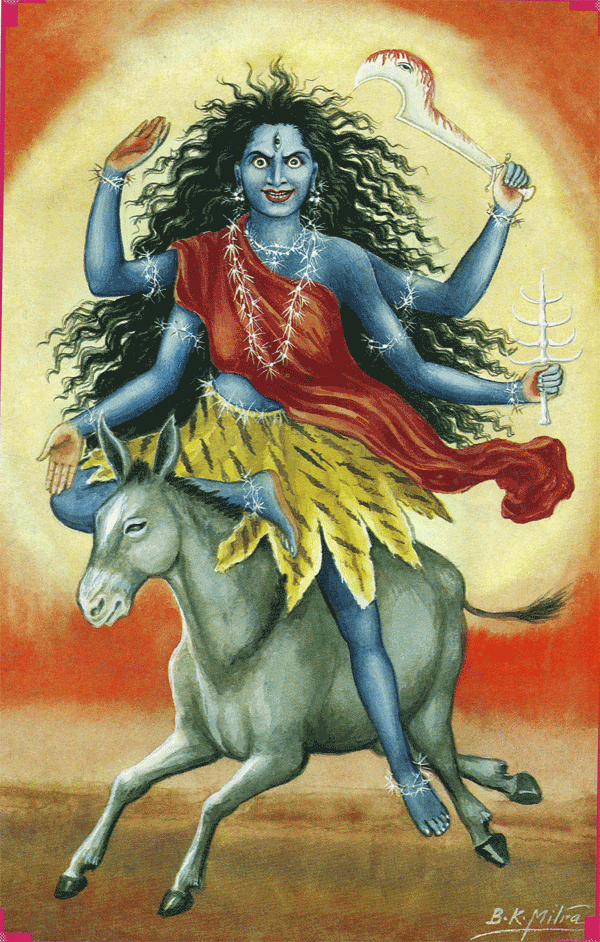 On the seventh day of Navaratri we worship Goddess as Kalaratri, a dark and fierce form of Durga. She has wild black hair, dark complexion, three red eyes, and flaming nostrils. She rides a donkey, and carries a sword and a cleaver in two hands, while her two other hands are in mudras offering blessings and protection. “Kala” refers to time, darkness, and therefore death. “Ratri” is night, and the presence of this goddess signifies a night of facing death and darkness. She reminds us that these are parts of the experience of life. By facing these aspects, and by worshipping Kalaratri, we can be freed from the pain and suffering associated with them. She is by our side bravely and compassionately as we face the morbid and terrifying aspects of existence, and helps to destroy our fears and weaknesses, giving us great strength.
On the seventh day of Navaratri we worship Goddess as Kalaratri, a dark and fierce form of Durga. She has wild black hair, dark complexion, three red eyes, and flaming nostrils. She rides a donkey, and carries a sword and a cleaver in two hands, while her two other hands are in mudras offering blessings and protection. “Kala” refers to time, darkness, and therefore death. “Ratri” is night, and the presence of this goddess signifies a night of facing death and darkness. She reminds us that these are parts of the experience of life. By facing these aspects, and by worshipping Kalaratri, we can be freed from the pain and suffering associated with them. She is by our side bravely and compassionately as we face the morbid and terrifying aspects of existence, and helps to destroy our fears and weaknesses, giving us great strength.
She is an expression of Kali, whose fearful form was birthed from Durga’s third eye when Durga needed more strength and ferocity to fight the demon Raktabija. She is also called Shubhankari, she who does auspicious deeds, and reminds us that we have nothing to fear from her, and nothing to fear, ever. The compassionate energy of the Divine Mother is always working through all parts of creation, even in the processes of destruction. Kalaratri rules Saturn (Shani), who also represents time and ultimate death, and offers us the opportunity for expanded consciousness through meditation on these inevitabilities. By worshiping Kalaratri on the seventh day of Navaratri and meditating on her deeply, we connect with the sahasrara (crown) chakra, and the barriers between mind, body, and spirit begin to dissolve. She blesses us with happiness and courage, helping to remove sadness, pain, and fear.
In some areas, the seventh day of Navaratri begins the worship of Sarasvati. Having worshipped Durga and Lakshmi for three days and nights each, to remove obscacles and obtain spiritual wealth. Now the devotee is ready to receive knowledge, which comes from Sarasvati, the goddess of learning. In other schools of worship, such as Kalikula in Nepal, Sarasvati is celebrated for the first three nights, followed by Lakshmi, and the last three nights are dedicated to Kali.
Eighth Day of Navaratri: Goddess as Mahagauri
Tuesday, October 20th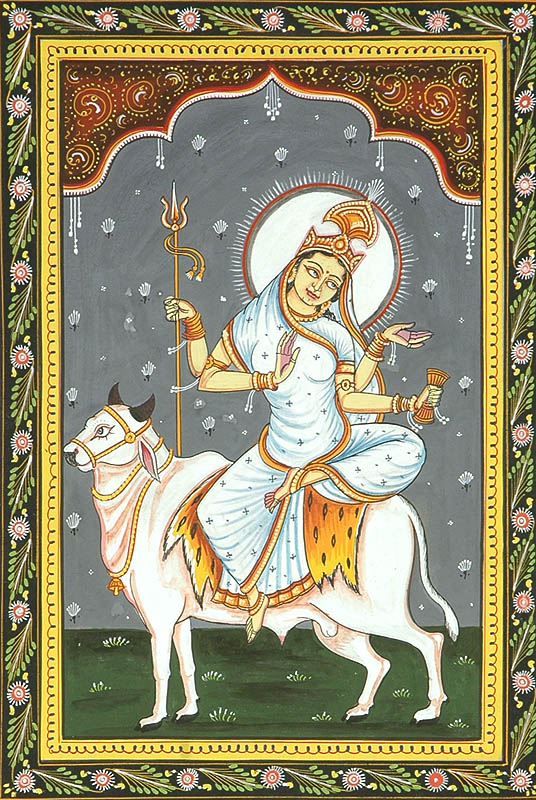
On the eighth day of Navaratri we worship Goddess as Mahagauri, the “great white goddess.” This incarnation of Durga is fair, shining and radiant like pure light, representing her purifying shakti. She rides a bull and carries a damaru (a hand-drum) and a trisul in two hands, keeping the other two in mudras for blessing and protecting. She represents compassion, truth, and purity and bestows these on her devotees. Mahagauri is often thought of as the young form of Parvati, and thus worshipers often feed young girls sweets on this day of celebration, to honor the great white goddess.
The story is often told that while Parvati was doing penance to win Lord Shiva, her body became black and dirty. When Shiva accepted her he washed her with the water of the Ganga which made her shine resplendently and become Mahagauri. This represents her power to free us from all pain and suffering and to bless us with auspiciousness and virtues, those who bathe in the waters of the holy river Ganga are said to be blessed and purified. This includes freeing us from the painful attachments to the material world. As we worship Mahagauri only after the night of worship dedicated to Kalaratri, we can see that this detachment and reemergence into the light can come only after facing death and darkness. This goddess relates to the planetary deity Rahu (the north node of the Moon), who is actually a shadow point in the cosmos and has no physical body. Thus Mahagauri relates to parts of our soul and psyche that are beyond the physical body or chakra system. By making offerings to and meditating upon her, we can begin to go beyond our attachments to the mundane details of life and purify our connection with spirit.
Ninth Day of Navaratri: Goddess as Siddhidatri
Wednesday, October 21st
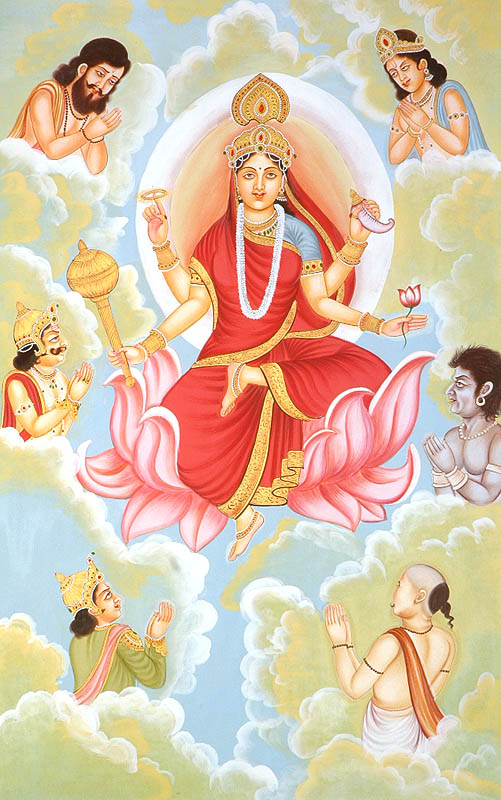 The ninth day of Navaratri is of utmost importance. On this day we worship Goddess as Siddhidatri, the giver of all siddhis, special powers or perfect attainments. Siddhis are magical, spiritual, or psychic powers, attained through dedication and devoted practice. Through worship and meditation upon all the forms of Durga, culminating with that of Siddhidatri, we can attain perfection and infinite blessings from her. Through the siddhis, all desires can be fulfilled. But it is said the greatest blessing one can receive is to transcend all desires, or to have one’s only desire be to know Goddess/God. With the blessing of devotion, through her grace, we can remain peaceful and happy in all circumstances, blissfully experiencing the Divine Mother’s presence in and throughout all of creation, in every moment.
The ninth day of Navaratri is of utmost importance. On this day we worship Goddess as Siddhidatri, the giver of all siddhis, special powers or perfect attainments. Siddhis are magical, spiritual, or psychic powers, attained through dedication and devoted practice. Through worship and meditation upon all the forms of Durga, culminating with that of Siddhidatri, we can attain perfection and infinite blessings from her. Through the siddhis, all desires can be fulfilled. But it is said the greatest blessing one can receive is to transcend all desires, or to have one’s only desire be to know Goddess/God. With the blessing of devotion, through her grace, we can remain peaceful and happy in all circumstances, blissfully experiencing the Divine Mother’s presence in and throughout all of creation, in every moment.
In her depiction, Siddhidatri sits on a lotus or a lion and holds a discus, a lotus, a mace, and conch shell, which she will use to sound the victory we attain through her worship. She is surrounded by and worshipped by all forms of divine beings–Gods, demons, spiritual masters and nature-spirits. It is said that even Lord Shiva received his powers from Siddhidatri. In the divine form that is half Shiva and half Shakti, he is merged with Siddhidatri and known as Ardhanarishvara. Siddhidatri relates to Ketu (the south node of the Moon), and thus she governs our deep and ancient psychic wisdom. She is a powerful goddess to worship for enhancing spiritual, psychic and energetic healing powers.
The Tenth Day of Navaratri: Vijayadashami
Thursday, October 22nd
The tenth day of Navaratri is known as Vijayadashami, the day of victory. After calling upon the Divine Mother’s presence and qualities to arise from within us for nine days and nights, we emerge victorious, basking in Her light and virtues. This is an auspicious time for beginning new ventures, especially creative and spiritual pursuits.
Jai Ma Durga!
I offer personal Vedic Astrology readings which can provide insight into the aspects of Shakti as well as the planetary forces you can work with in order to understand and master your personal strengths, challenges, and life course better. Click Here to order a reading and sign up for free Vedic Astrology news!
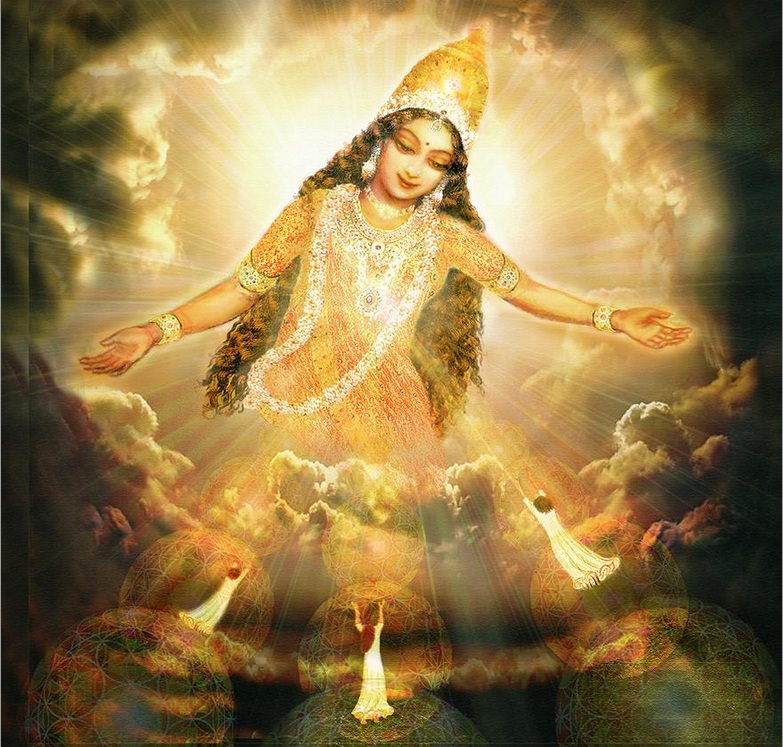
by Somya Devi | Oct 10, 2015 | Astrology, Conjunctions, Events, Holy Days
New Moon in Virgo in Chitra Nakshatra and Navaratri
As we complete the most recent lunar cycle which brought two powerful eclipses, we are settling into the effects and transformation that they brought to our lives. The solar and lunar eclipses of September were the last of a series to occur with the nodes in sidereal Virgo and Pisces, where they have sat since July 2014. Lessons that we have been working on through this time have taken on a new light, and many of us are now ready to face change and growth, whether it be in career, relationships, residence, or other important areas of life that have recently transformed.
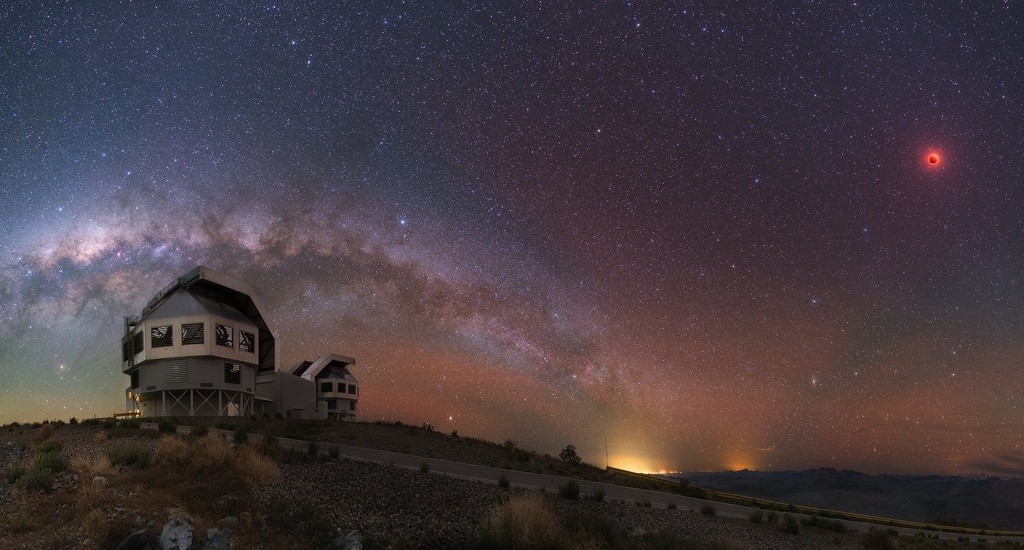 The New Moon in Virgo in Chitra nakshatra occurs on October 12th and offers us a day (and night) of stillness and darkness to sit with the changes, go inward and reflect, and prepare for the next lunar cycle. This Dark Moon phase will be from around 3pm PDT on October 11th until 5:05 pm on October 12th, at which time the Moon and Sun will be at a conjunct longitude (commonly called the New Moon). This conjunction happens near the end of Virgo constellation, in the Vedic nakshatra called Chitra. After that point the Moon begins its waxing phase, and the new lunar month.
The New Moon in Virgo in Chitra nakshatra occurs on October 12th and offers us a day (and night) of stillness and darkness to sit with the changes, go inward and reflect, and prepare for the next lunar cycle. This Dark Moon phase will be from around 3pm PDT on October 11th until 5:05 pm on October 12th, at which time the Moon and Sun will be at a conjunct longitude (commonly called the New Moon). This conjunction happens near the end of Virgo constellation, in the Vedic nakshatra called Chitra. After that point the Moon begins its waxing phase, and the new lunar month.
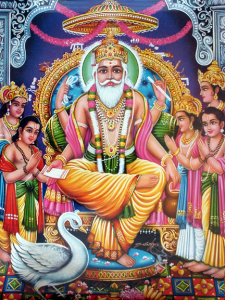 Chitra means “the brilliant” and is a very creative place in the zodiac. The deity for Chitra is Vishvakarma, the divine architect of the cosmos. This month we will feel inspired to create and to perfect our creations, just as the architect creates the universe in perfection. We will be attracted to investigate the mystery behind that divine creation. Gemstone medicine is powerful now, as gems are a symbol of this star. Chitra also relates to magic, and it is a time to tap into the powerful forces of magic within ourselves, and let them shine brightly.
Chitra means “the brilliant” and is a very creative place in the zodiac. The deity for Chitra is Vishvakarma, the divine architect of the cosmos. This month we will feel inspired to create and to perfect our creations, just as the architect creates the universe in perfection. We will be attracted to investigate the mystery behind that divine creation. Gemstone medicine is powerful now, as gems are a symbol of this star. Chitra also relates to magic, and it is a time to tap into the powerful forces of magic within ourselves, and let them shine brightly.
Beginning this cycle in Virgo, and with Sun and Moon joined with exalted Mercury there, we feel Mercury’s influence compelling us to seek understanding, and to organize the details around our creative pursuits. The second half of Chitra falls in Libra (as will the Sun during much of this lunar cycle), and under Venus’s influence, we may also feel called to balance our relationships this month. Mars is the nakshatra ruler for this star, and he brings us an energy, along with the fire element, that helps fuel along our creativity. There may be more emphasis on sexuality this cycle. Chitra is itself a balancing point in the zodiac, being the middle (14th) of the 27 nakshatras, so we seek harmony in all things as we prepare for the next season.
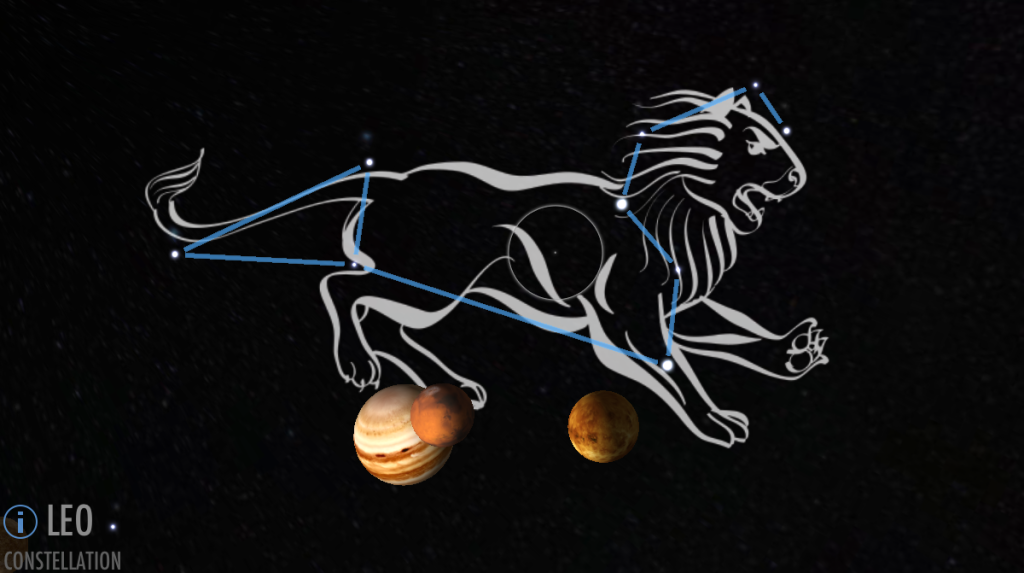 For most of this cycle (through November 2nd), we also experience the influence of Jupiter, Venus, and Mars all joined in Leo. This will make us give a lot of importance to the things all three of these planets represent (beliefs, desires, and personal will). At times this could create conflict (especially when they pass over each other in close conjunction), but in general it gives us a lot of energy. Jupiter in Leo energizes our belief systems, giving our philosophies a lot of weight in our decision-making process. Venus in Leo makes our desires come to the forefront, and we must be careful not to be too indulgent or selfish when it comes to getting what we want (whether it be in relationships or in our pursuit of beauty and recreation). Mars in Leo adds extra fire to the planet of action, will and energy, which could be good for our personal physical discipline, but could also cause us to get aggravated and argumentative over our philosophies and desires. Turn that Martian energy on yourself instead of getting hot-headed with others (read: time to reboot your workout routine or asana practice!). Sun’s rulership of Leo gives us the opportunity to work on purifying and refining all of these things this month–our beliefs, our desires, and our instinctual energy driver.
For most of this cycle (through November 2nd), we also experience the influence of Jupiter, Venus, and Mars all joined in Leo. This will make us give a lot of importance to the things all three of these planets represent (beliefs, desires, and personal will). At times this could create conflict (especially when they pass over each other in close conjunction), but in general it gives us a lot of energy. Jupiter in Leo energizes our belief systems, giving our philosophies a lot of weight in our decision-making process. Venus in Leo makes our desires come to the forefront, and we must be careful not to be too indulgent or selfish when it comes to getting what we want (whether it be in relationships or in our pursuit of beauty and recreation). Mars in Leo adds extra fire to the planet of action, will and energy, which could be good for our personal physical discipline, but could also cause us to get aggravated and argumentative over our philosophies and desires. Turn that Martian energy on yourself instead of getting hot-headed with others (read: time to reboot your workout routine or asana practice!). Sun’s rulership of Leo gives us the opportunity to work on purifying and refining all of these things this month–our beliefs, our desires, and our instinctual energy driver.
 During the first nine days and nights of the waxing Moon this month, Navaratri is celebrated (starting October 13th in North America). Literally the “nine nights,” this is a Hindu festival dedicated to worshiping the Goddess, Devi, in her many forms, for nine days and nights. As the night represents darkness and ignorance, we pray to her to help reveal and remove our shortcomings, bestow blessings, and confer wealth and knowledge. We face the darkness and call on the Divine Mother to remove it and let the Atma, or the pure divinity within each of us, shine forth. Navaratri worship can include creating a special altar to the Goddess, and making daily offerings including flowers, food, incense, light (a flame), ghee, as well as prayer, fasting, meditation, mantras and bhajans (devotional songs). The Devi Mahatmya (a.k.a. Chandi Path), the story of Durga, is a traditional text to read throughout this festival. In some places Devi is worshipped over the nine nights in reverence to nine incarnations of Durga: Shailputri, Brahmacharini, Chandraghanta, Kushmanda, Skandamata, Katyayani, Kalaratri, Mahagauri and Siddhidatri. Occurring in the fall-time in India and the northern hemisphere, this Navaratri also coincides with the harvest season, and is a great time to give thanks for the abundance of the harvest and pray that it carries us through the winter season.
During the first nine days and nights of the waxing Moon this month, Navaratri is celebrated (starting October 13th in North America). Literally the “nine nights,” this is a Hindu festival dedicated to worshiping the Goddess, Devi, in her many forms, for nine days and nights. As the night represents darkness and ignorance, we pray to her to help reveal and remove our shortcomings, bestow blessings, and confer wealth and knowledge. We face the darkness and call on the Divine Mother to remove it and let the Atma, or the pure divinity within each of us, shine forth. Navaratri worship can include creating a special altar to the Goddess, and making daily offerings including flowers, food, incense, light (a flame), ghee, as well as prayer, fasting, meditation, mantras and bhajans (devotional songs). The Devi Mahatmya (a.k.a. Chandi Path), the story of Durga, is a traditional text to read throughout this festival. In some places Devi is worshipped over the nine nights in reverence to nine incarnations of Durga: Shailputri, Brahmacharini, Chandraghanta, Kushmanda, Skandamata, Katyayani, Kalaratri, Mahagauri and Siddhidatri. Occurring in the fall-time in India and the northern hemisphere, this Navaratri also coincides with the harvest season, and is a great time to give thanks for the abundance of the harvest and pray that it carries us through the winter season.
In some places, the first three nights of Navaratri are dedicated to Goddess in the form of Durga or Kali, who help us to destroy and remove negative tendencies in our minds and hearts, cleansing them of impurities that create obstructions in our spiritual and material pursuits. The next three nights are dedicated to Goddess in the form of Lakshmi, who helps us to cultivate positive qualities, like compassion and devotion. She helps us to achieve spiritual and material prosperity. In the final three nights we worship Goddess as Sarasvati, who assists us with learning and attaining knowledge and wisdom, through the illumination of consciousness. She relates to prana, the vital breath, often associated with chi or life-force. Through our devotion, service, practice, study, and meditation (all forms of yoga), we allow prana to flow freely, helping us to exist in a state of peace, bliss, and oneness. The tenth day of Navaratri is known as Vijayadashami, the day of victory. After calling upon the Divine Mother’s presence and qualities to arise from within us for nine days and nights, we emerge victorious, basking in Her light and virtues. This will be an auspicious time (October 22nd) for beginning new ventures, especially creative and spiritual pursuits.

by Somya Devi | Apr 20, 2015 | Astrology, Planets Changing Signs, Uncategorized
From today through Wednesday morning (PDT) there is a really graceful alignment of planets in the sky. Five planets are either in their own signs or their signs of exaltation. This combination or “yoga” in Vedic astrology is a powerful one, and grants auspiciousness to activities undertaken during this time. Mars and Venus are in signs that they rule (Aries and Taurus, respectively), and the Sun, Moon, and Jupiter are in their signs of exaltation (Aries, Taurus, and Cancer). This means that we will find it easier to connect with our courage and strength for acting (Mars), with spirit and illuminated consciousness (Sun), with peace and contentment in our hearts (Moon), with finding happiness and beauty in life, and through compromise and relationships (Venus), and with our senses of higher purpose, hope and optimism (Jupiter). We will have five exalted or sva planets (in their own signs) again when Moon passes through his own sign, Cancer, from Friday through Sunday morning. For the next two days, however, with the Sun and Moon exalted, we are in the auspicious Hindu holy days of Akshaya Tritiya. The “tritiya” refers to the third day of the waxing moon, and each year on the third day after new Moon in Aries, both Sun and Moon are exalted (Sun in Aries and Moon in Taurus). “Akshaya” means “never diminishing” and is associated with prosperity and wealth. This is a good time for beginning both material and spiritual ventures. With Mars and Sun in Aries, we already have a lot of potency for initiating activities, and with Moon also exalted, this aligns us with our heart’s truest contentment. Moon is exalted in Taurus because the emotions are able to rest peacefully in that fixed earth sign. It is a Kapha dosha sign, which supports the emotional body because it is less prone towards restlessness and anxiety. With a full spirit and peaceful heart, and a strong connection to your strength, pleasure and purpose, do some work these days on manifesting your dreams.
Some times of day are even more potent than others for setting your goals in motion, and as well you may find this window especially graceful for activities related to the specific houses affected in your chart.
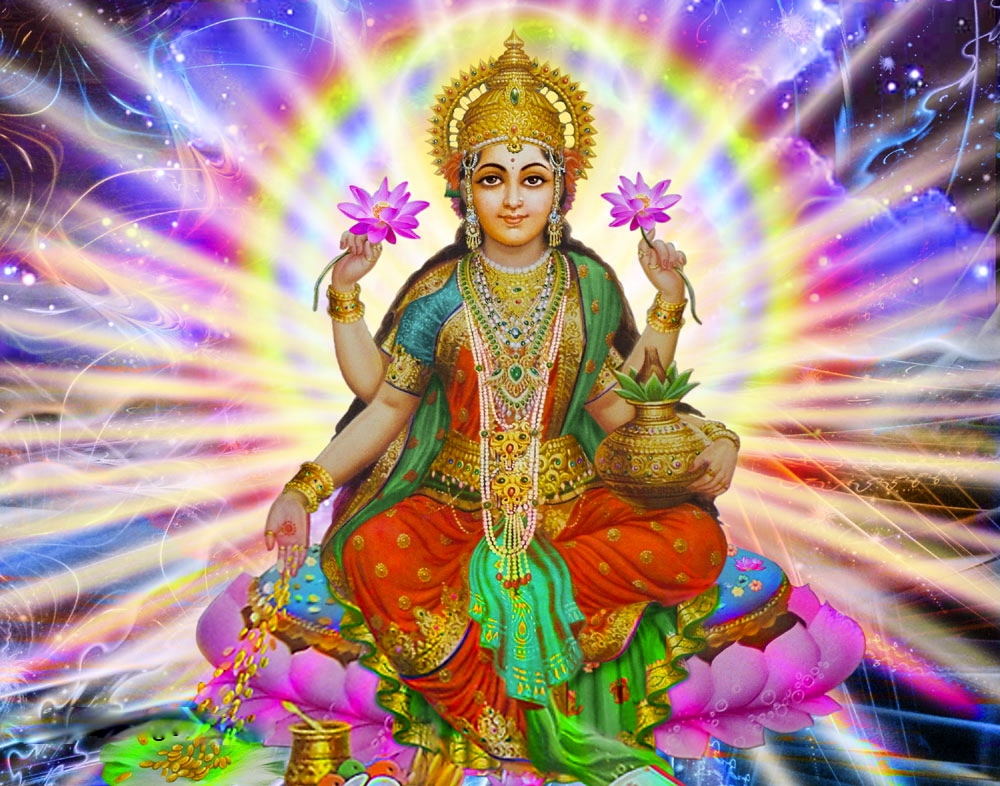


 Navaratri worship can include creating a special altar to the Goddess, and making daily offerings including flowers, food, incense, light (a flame), ghee, as well as prayer, meditation, mantras and bhajans (devotional songs). The Devi Mahatmya (a.k.a. Chandi Path), the story of Durga, is a traditional text to read throughout this festival. Occurring in the fall-time in India and the northern hemisphere, this Navaratri also coincides with the harvest season, and is a time to give thanks for the abundance of the harvest and pray that it carries us through the winter season.
Navaratri worship can include creating a special altar to the Goddess, and making daily offerings including flowers, food, incense, light (a flame), ghee, as well as prayer, meditation, mantras and bhajans (devotional songs). The Devi Mahatmya (a.k.a. Chandi Path), the story of Durga, is a traditional text to read throughout this festival. Occurring in the fall-time in India and the northern hemisphere, this Navaratri also coincides with the harvest season, and is a time to give thanks for the abundance of the harvest and pray that it carries us through the winter season.
 Also remember, most Western astrologers will say that Jupiter has been in Libra for the last year already, which can cause some confusion. That is based on the tropical zodiac, based on the seasons. Now is a great example of how the tropical zodiac does not correlate with the observable position of the planets and constellations as we see them from earth.
Also remember, most Western astrologers will say that Jupiter has been in Libra for the last year already, which can cause some confusion. That is based on the tropical zodiac, based on the seasons. Now is a great example of how the tropical zodiac does not correlate with the observable position of the planets and constellations as we see them from earth.


















